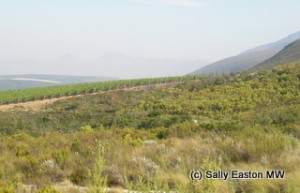South African shiraz
A version of this article first appeared in Australia’s Winestate magazine, Sept/Oct 2009.

Shiraz in the Bot River
Shiraz has seen something of an explosive growth in South Africa. Plantings have increased from 2% of the vineyard area just over a decade ago, to 10% today. It is now the fourth most planted variety in South Africa, after chenin blanc, cabernet sauvignon and colombard. Sauvignon blanc and chardonnay are next.
Part of this rapid increase is a wider trend to grow more ‘international’ varieties – chenin blanc is coming down – not surprising considering it used to comprise one-third of the vineyard area less than a generation ago, now down to less than 20% – as well as colombard in the whites. Merlot and cabernet sauvignon are on the up, but not near the growth rate of shiraz, which has really become the flavour of the month.
Another part of the trend is the changing political situation in South Africa. Su Birch, CEO of Wines of South Africa, the generic promotional organisation, pointed out just how young the industry is in real terms saying: “until 1992 you couldn’t plant grapes unless you had a quota from the KWV (a co-operative established in 1918 to stabilise the industry). And you could only export through the KWV. There was a pool of cheap and cheerful wines and 85% of the vineyard was colombard and chenin blanc. In 1994 we achieved democracy. So we are only a 15 year old industry, and had to drag ourselves up from a low position.”
The achievement of democracy has allowed producers to break out of traditional wine-growing regions and explore brand new ones, many of which are towards the coast – of both the Atlantic and Indian Oceans, and others have sought increasing altitude, not just for shiraz, but for other varieties too, notably sauvignon blanc.
Of course shiraz loves warmer climates, and South Africa has plenty of those, and this is one of the reasons it is thought to have so much potential in the country. It’s in these traditional regions where the earlier shiraz plantings are – Swartland, Paarl and Stellenbosch. One of the things that is new within the warmer regions is a trend to smaller scale production, with lower yields and more terroir-related results. People like Eben Sadie of Sadie Family Wines were one of the early ones, at the turn of the millennium, to make wines of acclaim in Swartland, with his Columella blend of mainly shiraz with some mourvèdre.
Swartland, 50 miles north east of Cape Town, has seen a boom for shiraz. Prices were relatively inexpensive in this pretty hot, dry climate, which gets some differences in vineyard climate due to its relative proximity to the Atlantic Ocean, and this encouraged new winemakers wanting to make a name for themselves. Stalwart of the region though, with more than 60 years experience, is the Swartland Winery, representing 200 growers, and bringing in fruit from a 20 mile radius, which gives enough fruit character differences to offer interesting blending opportunities.

Sorting shiraz berries at Saronsberg
A little further inland, to the north-east, is Tulbagh, with a continental climate, dry and hot during the day, though differences in day and night-time temperatures are also quite marked. Here, Saronsberg, whose first vintage was 2004, have more recently being making medal-winning shiraz. The shiraz 2006 won Gold at the Veritas and Double Gold at the Michaelangelo Awards in South Africa, and their Full Circle 2006 (shiraz, mourvèdre, viognier) also got Gold at Veritas and five stars (the maximum) in the UK’s Decanter magazine tasting.
Their winemaker, Dewaldt Heyns explained their rapid success: “It’s hot and we’ve adapted to the area. We’ve worked against the heat and abundant sunshine by changing row direction, the canopy system and trellising height and by lowering yield.”
Given how recent is the surge in shiraz plantings, the vines at Saronsberg are quite old by comparison with many at an envious 10-12 years old, just coming into their prime. This no doubt plays a part in the consistent success the winery has had with their past few vintages, and Heyns added: “We want to create stunning wines. Our wines are fairly big and bold with a measure of elegance. We work with skins but we de-stem everything. Our biggest bonus which helps a lot is our hand-sorting system, we have tight selection, and yields are very low, about 28 to 32 hl/ha.
“We also pre-cool the grapes before start anything. We take the temperature down very quickly; we were the first cellar in South Africa to use this system and we feel it helps with quality.” Of course he said “we pick early morning, and are finished by 9am.”
Saronsberg is making shiraz something of a speciality, and the variety accounts for 40% of their plantings. In trying to identify the reasons for their success, Heyns said: “we try to take all the small things you can do to make a better wine. Each contributes a small amount, and you just need 1 or 2% to elevate the quality level to something different.”

La Motte's Edmund Terblanche
Saronsberg are the boutique end of things. Total production is just 12,000 cases. But a different approach is that of La Motte. They were an estate, meaning they could only use fruit grown on their property in Franschhoek, but they de-regulated which allows them to buy fruit from any wine-producing area in the country. As Edmund Terblanche, their winemaker, said: “this where the future lies – there’s too much diversity [in South Africa] to harvest just from one wine-farm.” This is certainly something with which Australia is familiar.
It was in 2002, said Terblanche “that we decided to go for shiraz more, and make different styles.” It has become something of a flagship variety for them. They bought another vineyard 60 miles away in Bot River, near Walker Bay and these two wine-farms supply the bulk of La Motte’s needs. But said Terblanche “we also get fruit from Darling, Wellington, and Paarl, and lately we’re looking for more cool-climate grapes from emerging areas such as Elim.”
Terblanche is also the chairman of the Shiraz Association in South Africa, a group that hopes to emulate the achievements of the Pinotage Association. It was only last October they formally got together, and they are yet to decide a corporate identity and website. But, Terblanche said “we have the potential to become a strong body. Shiraz is the second most planted red. There are over 700 labels for shiraz in South Africa, yet in 1992 there were just 50. And South Africa is the fourth biggest producer of shiraz in the world.”



